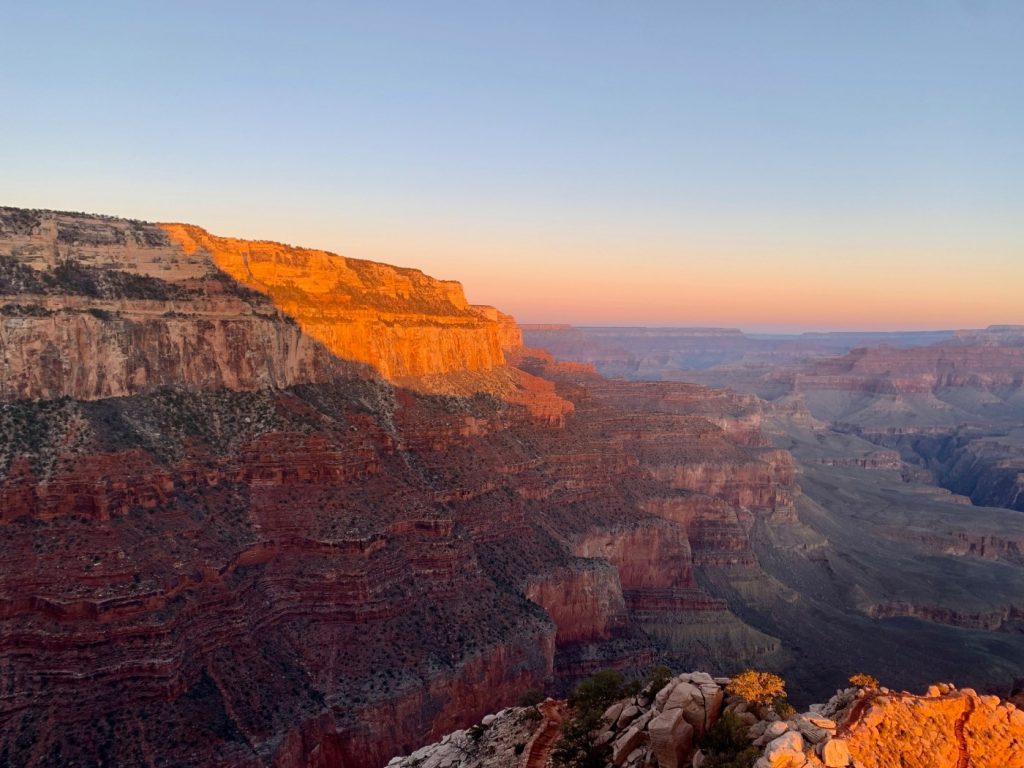Nearly a year ago, when my friend Nina told me she’d scored a noncommercial permit to raft through the Grand Canyon, I had no idea how lucky she was – or how lucky I would be, after she invited me to join her Colorado River expedition.
The National Parks Service uses a weighted lottery system each February to award these noncommercial rafting permits, just 495 of them last year. (There are also, of course, park-approved commercial raft trips through portions of Grand Canyon National Park that last anywhere from 1 to 18 days). Nina’s permit authorized her to rally a group of 16 people at a time — more on that in a sec — to traverse the 225 miles between Lees Ferry and Diamond Creek in 16 days.
Hailing from across the U.S., our group of rafters convened in snowy Flagstaff just before St. Patrick’s Day, packed up our gear with our outfitters, Moenkopi Riverworks, and headed for Lee’s Ferry. It was remarkable how much food and gear could be crammed into four, inflatable 18-foot rafts and one 15-footer. We even brought a propane-fueled fire pit. Each raft had a seasoned captain, and four had rafted through the Grand Canyon several times.
Designated campsites of various sizes dotted the route along the Colorado River. (Courtesy Nina Frankel)
We quickly fell into a rhythm, starting each morning with coffee and breakfast, before packing up our gear and paddling off to our next destination 10 to 20 miles downriver. The atmosphere felt a bit like summer camp for adults, a little wilderness expedition-meets-vacation, complete with DIY meal kits ready to be cooked up on our heavy-duty outdoor kitchen.
About 33 miles down the Colorado River from Lee’s Ferry, Redwall Cavern offers a shady destination for lunch — and cartwheels. (Courtesy Jennifer Sparks)
Without internet or cell service tethering us to our outside lives, friendships quickly developed, and new discoveries awaited around every bend in the river. There were the Roaring Twenties, a series of splashy and fun rapids that felt like nature’s version of a roller coaster. There was Nautiloid Creek, where a quick side hike yielded views of nautilus fossils embedded in the rocks, and Nankoweap, a side hike to a set of Native American granaries.
A little after mile 61, we passed the point where the flooded Little Colorado River met the Colorado. The water took on a milky chocolate color, fine sediment blending into the water source that’s critical to a wide swath of the western U.S.
Our first few days flew by in a rush to make it to Phantom Ranch (mile 89) by day 5 and swap out four members of our party for four other friends, who had hiked in to meet us. There, we experienced the closest thing to civilization available at the bottom of the Grand Canyon — outhouses and a gift shop with ice-cold lemonade and postcards you can send out of the canyon via mule.
The author traveled on a 16-day rafting expedition down the Colorado River through the Grand Canyon and spent time at the oars learning to row. (Courtesy Samuel Streeter)
Then it was onward down the river, with the current propelling us along. Rafters took turns rowing, sitting forward or backward at the oars, depending on preference. It took me several days of frustrated practice, but once I got it down, there was something delightfully meditative about pulling and pushing the boat along the river. I even got to row some of the smaller rapids, which felt pretty thrilling.
As we plunged deeper into the canyon, new layers of rock emerged. There was grey and yellowish Muav limestone, greenish Bright Angel shale and Tapeats sandstone, which looked like walls of layered 500-million-year old pancakes. The Vishnu schist — the Grand Canyon’s 1.7 billion-year-old “basement layer” — was veined with pink stripes of Zoroaster granite.
Near miles 117, we came to Elves Chasm, a stunning side canyon oasis with a swimming hole and trickling waterfall. It was a perfect spot for cooling down as the days started to warm.
At Blacktail Camp, we passed a slot canyon with a little cavern, where a couple of friends put on an impromptu ukulele and guitar performance. Just behind them at eye level, we could see the Great Uncomformity – a horizontal break in the rocks where about a billion years of geologic time has disappeared. Time is captured in the rocks throughout the canyon, but here, there is nothing. It felt sacred and a little eerie to be singing along to the group’s rendition of Noah Kahan and Caamp songs in an ancient slot canyon where a billion years can disappear without a trace.
The towering ancient rock walls of the Grand Canyon were on view from the granaries at Nankoweap. (Kate Bradshaw/Bay Area News Group)
And the journey continued. We stopped to explore the Doll’s House (mile 131), a schist ridge polished by the river into a maze that welcomed exploration. (It was also the scouting spot for one of the more treacherous rapids we faced, the Class 7 Bedrock. Rapids on the Grand Canyon are categorized on a scale of 1-10 rather than the more standard 1-6 scale.)
A couple of miles down the river, we camped near Tapeats Creek and took a hiking trail up and over to Deer Creek. It was one of the more maintained trails; many of our outings felt like rock scrambles over unmarked terrain
One of the trip highlights was a stop at Havasu Canyon, where the water suddenly turned turquoise. We waded through chest-deep water, as the slot canyon opened up into a mini-paradise with lush greenery, cool shade and the bluest water I’d ever seen.
It was a mellow moment as we prepared for the final large rapid — the biggest and most dangerous — of the journey: Lava.
One of the best-maintained hiking trails from the Colorado River in the Grand Canyon was the Tapeats Creek to Deer Creek hiking route. (Courtesy Jennifer Sparks)
Anxiety about these Class 9 rapids had built up for days. The Grand Canyon inspires a certain sense of reverence and superstition toward the river gods, so we held a goofy group ceremony — just in case — to give our thanks to the river and honor its power. It seemed an especially good idea moments later, as the landscape suddenly changed, the water roiling through canyon walls studded with black basalt chunks and the remnants of volcanic flows — and our rafts passed through safely.
Afterward, we indulged in the time-honored river tradition of a visit to Tequila Beach, nicknamed for reasons that certainly don’t involve the consumption of questionable quantities of celebratory alcohol.
Two days later, on Easter Sunday, we awoke to a camp filled with hidden Easter eggs containing slips of paper with dares. Hijinks ensued.
Surrounded by ancient and majestic landscapes on the Colorado River, rafters enjoyed each other’s company, including one day when all the women in the group crowded onto a single raft. (Courtesy Emily Blackmer)
Soon, we’d made it to Diamond Creek and the take-out — and the first place since the journey began 225 miles ago with a road out, albeit a bumpy dirt one.
After unloading and disassembling our boats, we traveled out to Route 66, where I had a cathartic encounter with an A&W. After so many days off-grid, I’d never been more excited to experience flushing toilets and milkshakes. But what I gained on this journey — new friends, new arm muscles (sort of), new skills and whitewater lingo – was unforgettable.
If You Go
Whitewater rafting in Grand Canyon National Park generally requires advance planning, whether you’re on a guided commercial trip or a private one. Learn more at https://www.nps.gov/grca/planyourvisit/whitewater-rafting.htm. The park also works with concessioners to offer single and half-day smooth water trips from Page, Arizona; nps.gov/grca/planyourvisit/one-day-river-trip.htm.
For more travel coverage in the Bay Area and beyond, follow us on Flipboard.


